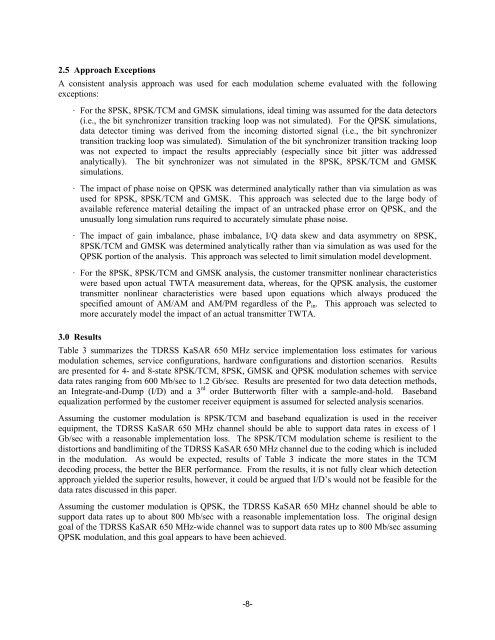AN ASSESSMENT OF THE BIT-ERROR-RATE ... - SpaceOps
AN ASSESSMENT OF THE BIT-ERROR-RATE ... - SpaceOps
AN ASSESSMENT OF THE BIT-ERROR-RATE ... - SpaceOps
You also want an ePaper? Increase the reach of your titles
YUMPU automatically turns print PDFs into web optimized ePapers that Google loves.
2.5 Approach Exceptions<br />
A consistent analysis approach was used for each modulation scheme evaluated with the following<br />
exceptions:<br />
· For the 8PSK, 8PSK/TCM and GMSK simulations, ideal timing was assumed for the data detectors<br />
(i.e., the bit synchronizer transition tracking loop was not simulated). For the QPSK simulations,<br />
data detector timing was derived from the incoming distorted signal (i.e., the bit synchronizer<br />
transition tracking loop was simulated). Simulation of the bit synchronizer transition tracking loop<br />
was not expected to impact the results appreciably (especially since bit jitter was addressed<br />
analytically). The bit synchronizer was not simulated in the 8PSK, 8PSK/TCM and GMSK<br />
simulations.<br />
· The impact of phase noise on QPSK was determined analytically rather than via simulation as was<br />
used for 8PSK, 8PSK/TCM and GMSK. This approach was selected due to the large body of<br />
available reference material detailing the impact of an untracked phase error on QPSK, and the<br />
unusually long simulation runs required to accurately simulate phase noise.<br />
· The impact of gain imbalance, phase imbalance, I/Q data skew and data asymmetry on 8PSK,<br />
8PSK/TCM and GMSK was determined analytically rather than via simulation as was used for the<br />
QPSK portion of the analysis. This approach was selected to limit simulation model development.<br />
· For the 8PSK, 8PSK/TCM and GMSK analysis, the customer transmitter nonlinear characteristics<br />
were based upon actual TWTA measurement data, whereas, for the QPSK analysis, the customer<br />
transmitter nonlinear characteristics were based upon equations which always produced the<br />
specified amount of AM/AM and AM/PM regardless of the Pin. This approach was selected to<br />
more accurately model the impact of an actual transmitter TWTA.<br />
3.0 Results<br />
Table 3 summarizes the TDRSS KaSAR 650 MHz service implementation loss estimates for various<br />
modulation schemes, service configurations, hardware configurations and distortion scenarios. Results<br />
are presented for 4- and 8-state 8PSK/TCM, 8PSK, GMSK and QPSK modulation schemes with service<br />
data rates ranging from 600 Mb/sec to 1.2 Gb/sec. Results are presented for two data detection methods,<br />
an Integrate-and-Dump (I/D) and a 3 rd order Butterworth filter with a sample-and-hold. Baseband<br />
equalization performed by the customer receiver equipment is assumed for selected analysis scenarios.<br />
Assuming the customer modulation is 8PSK/TCM and baseband equalization is used in the receiver<br />
equipment, the TDRSS KaSAR 650 MHz channel should be able to support data rates in excess of 1<br />
Gb/sec with a reasonable implementation loss. The 8PSK/TCM modulation scheme is resilient to the<br />
distortions and bandlimiting of the TDRSS KaSAR 650 MHz channel due to the coding which is included<br />
in the modulation. As would be expected, results of Table 3 indicate the more states in the TCM<br />
decoding process, the better the BER performance. From the results, it is not fully clear which detection<br />
approach yielded the superior results, however, it could be argued that I/D’s would not be feasible for the<br />
data rates discussed in this paper.<br />
Assuming the customer modulation is QPSK, the TDRSS KaSAR 650 MHz channel should be able to<br />
support data rates up to about 800 Mb/sec with a reasonable implementation loss. The original design<br />
goal of the TDRSS KaSAR 650 MHz-wide channel was to support data rates up to 800 Mb/sec assuming<br />
QPSK modulation, and this goal appears to have been achieved.<br />
-8-


